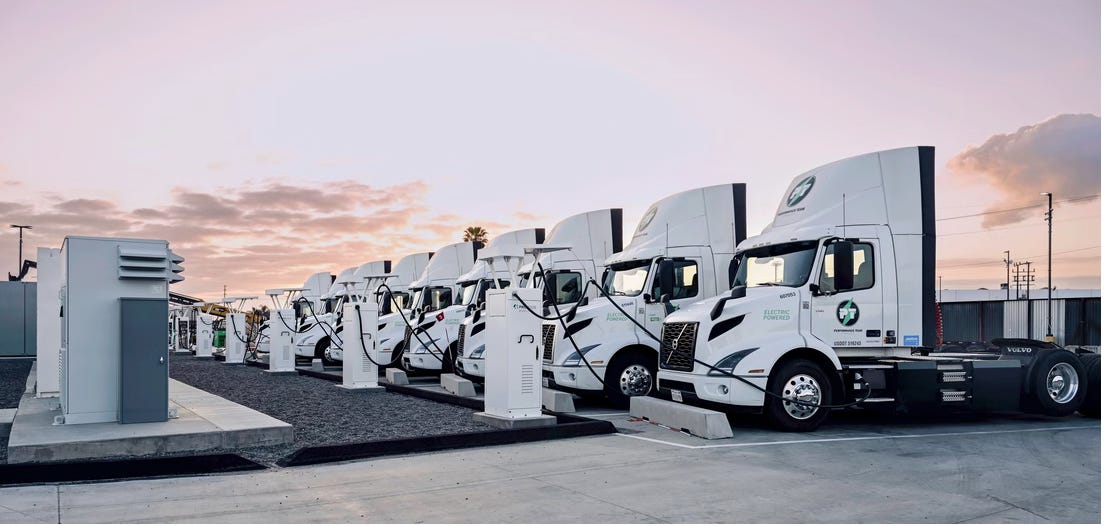North America’s keys to electrifying its port trucking fleet are in California
Maersk-Prologis initiative provides roadmap to shifting container trucks from diesel to battery electric – now
Asia-Pacific Gateway cargo flow question of the day: How far has the Vancouver Fraser Port Authority’s (VFPA) Rolling Truck Age Program (RTAP) got in its quest to decarbonize air pollution from the port’s land-side operations?
Last we heard, the deadline to prohibit trucks older than 12 years from accessing port terminals was set to kick in around April 2023; but last year the VFPA extended the deadline another nine months. The postponement, the third thus far, was in response to a groundswell of gripes from drivers whose trucks were more than 12 years old and consequently deemed to be major Port of Vancouver greenhouse gas emitters.
That deadline postponement underscores why difficult things don’t get done in Coddle Country. Especially things that hurt people’s feelings.
Down the coast in more decisive districts, toes are stepped on to get things done. Sorry about that.
Instead of delays, apologies and second thoughts, you get action.
Southern California, for example, is on the road to eliminating diesel trucks from servicing its San Pedro Bay port complex (Long Beach-Los Angeles). Its Clean Truck Program (CTP) has a target of 100% zero-emission container trucks servicing what is the world’s ninth busiest container cargo hub by 2035.
Back in B.C., truckers represented by the United Truckers Association (UTA) argue that emissions, not age, should determine a truck’s VFPA decarbonization compliance.
Good point.
But we are splitting hairs here for what is estimated to be less than 15% of the 1,800 trucks that pick up and drop off containers at Metro Vancouver port terminals.
Still, protests from that 15% can cause major cargo flow interruptions at a port that can ill afford anymore cargo flow disruptions.
Investing in new Class 8 trucks is not cheap. In Canada, a traditional diesel Class 8 would run you anywhere from $150,000 to $250,000. A comparable battery-electric model would cost around $450,000. That’s if a commercially viable battery-electric model were even available.
So, you don’t have to look much beyond initial capital cost to know why truckers are protesting RTAP regulations.
B.C. truckers are not alone in that protest. Beefs over California’s clean truck push abound.
To reduce the CTP’s financial impact, the San Pedro Bay port complex has established the Clean Truck Fund (CFT) to help finance the truck decarbonization transition. It collects US$20 per 20-foot-equivalent unit (TEU) on loaded import and export containers hauled by trucks in or out of the Los Angeles and Long Beach ports. Zero-emission trucks are exempt from the levy.
At last count, the CFT had raised around US$115 million.
But more than individual truck overhauls are required here. Zero-emission trucks are not going to get far without refuelling/recharging infrastructure. And that infrastructure requires major investment. A trucking industry-sponsored report from management consultancy Roland Berger concludes for example that converting 100% of U.S. heavy-duty trucks to electricity would require around US$620 billion for charging infrastructure alone.
But that is everything all at once, and everything all at once is not how North America is going to electrify its heavy-duty truck fleet.
Maersk’s (CPH:MAERSK-B) Performance Team subsidiary shows that portions of port trucking can be electrified now. Working with Prologis Inc.’s (NYSE:PLD) Prologis Mobility charging-as-a-service platform, the world’s second largest container shipping company recently unveiled a major electric truck charging hub near the Los Angeles-Long Beach port complex.

J.T. Steenkamp, Prologis Mobility’s director of Infrastructure Projects and Technology, said the Denker Avenue depot in Torrance, California, “can charge 96 trucks simultaneously, or cycle in and out about 300 trucks a day.” The Performance Team Volvo VNR electric trucks have a 240-mile range (around 390 kilometres) and can charge to 80% in 90 minutes. At full operation, the hub, which was completed in five months, would eliminate about 70 tonnes of diesel truck carbon dioxide a day, according to Prologis.
Meanwhile, Sweden’s Einride opened its first U.S. Smartcharger Station for electric trucks in Lynwood, California in March. The facility is on the I-710 near the San Pedro port complex and, according to Einride, can charge up to 200 trucks per day.
Battery electric heavy-duty trucks have yet to make many inroads in North America’s commercial trucking sector. EV adoption roadblocks range from initial capital costs and battery size to range limitations and inadequate charging infrastructure.
But Kate Jostworth, Maersk’s head of Growth Enablement First Mile Drayage, said the company has already logged four million electric truck miles on its net-zero land-side freight transportation journey.
Many of those miles have been difficult, because, as Jostworth said during a recent panel discussion on shifting truck fleets to EV technology from diesel, electrification transition “is not easy. It requires a lot of change management in all elements to be able to transition your costs, your timing, your driver behaviour, your dispatch [system] and how you make that transition from diesel to EV.”
But the Maersk plan shows that there is a commercially viable electric alternative to diesel today for container terminal trucking operations that will make more business sense tomorrow as electric truck technology costs decrease and market demand and pollution elimination imperatives increase.
It requires pairing innovation with corporate commitment and well-defined bipartisan government regulation.
That combination appears to be alive and well in California. No sign of it yet in Canada.
www.linkedin.com/in/timothyrenshaw
@trenshaw24.bsky.social
@timothyrenshaw



